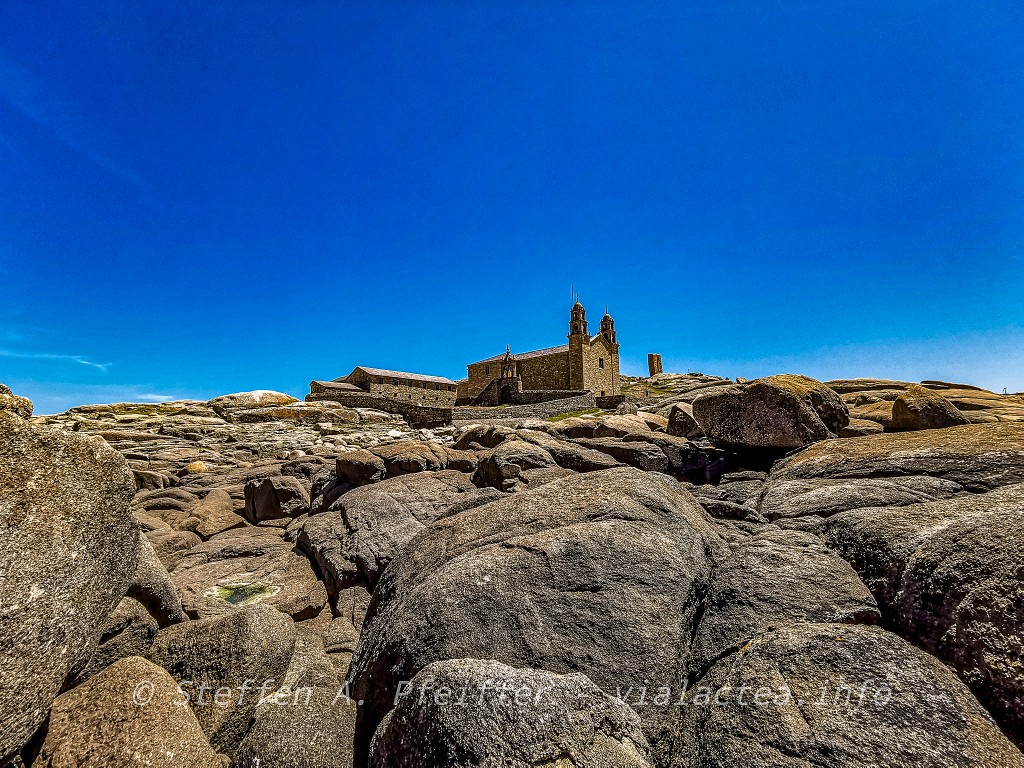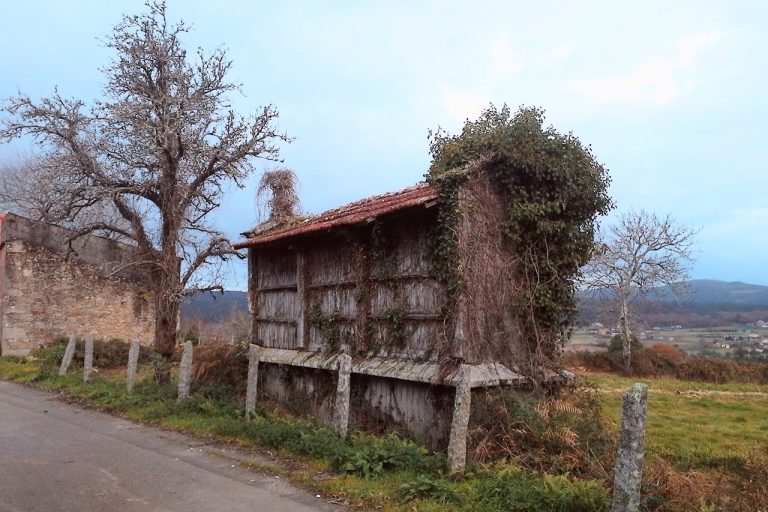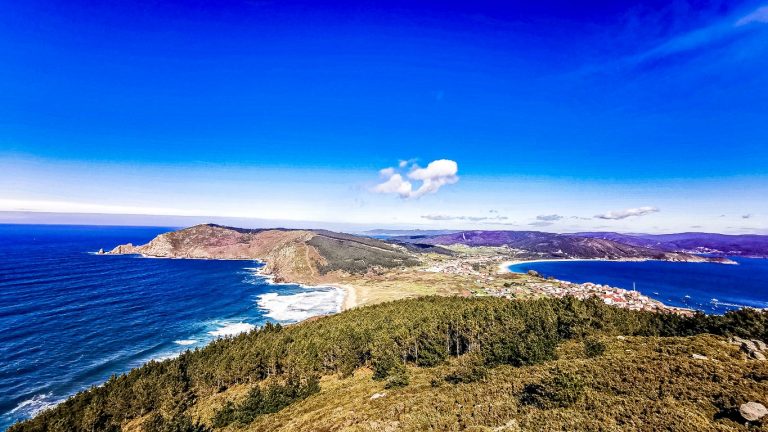
A new day on the Way – Beginning & Atmosphere
Morning in Olveiroa begins with mist. Between the old hórreos, the first light glimmers, and the breath of the cows drifts like steam across the meadows. It is quiet — only the tapping of walking sticks echoes over the cobblestones.
Today you walk north — not toward the “end of the world,” but to a place where sea and stone tell a silent story: Muxía, where the waves strike the rocks and the air smells of salt and wind.
At the edge of the village, the Camino divides. The stone marked with two scallop shells stands like a silent guardian by the path. You turn left — the way to Muxía. The trail descends into the valley of the Río Xallas. The mist remains behind you; the silence walks beside you.
Route & Elevation Profile
- Distance: approx. 31 km
- Elevation gain/loss: +510 m / –610 m
- Difficulty: moderate
- Duration: 7–8 hours
- Character: gentle hills, paths through fields and forests, quiet villages, later approaching the coast
This stage leads you from the inland heart of Galicia to the Costa da Morte.
The path is less well known than the one to Fisterra, yet no less moving — a route for those who wish to feel the Way just a little longer.









Description of the Way – With All Senses
You leave Olveiroa in the early morning, cross the stream, and begin a gentle ascent. After about one kilometer you reach Hospital, where the routes divide: right toward Fisterra, left toward Muxía. You follow the left shell.
The path continues along quiet country roads and farm tracks through Senande and Casais. The land opens up — fields, meadows, wind. A soft murmur of water accompanies you.
After around ten kilometers you arrive in Dumbría. A small bar, a shop, a bank — a short stop to regain strength. From here, the Camino passes through open countryside, past isolated farms and small streams.
The route climbs gently through Trasufre and Senande, then continues over soft hills to Quintáns (around km 21). There stands a small church that offers shade in summer. The AC-552 road is crossed several times — caution is needed here.
Afterwards, the path passes through Buiturón, then Moraime, where a Romanesque church with a peaceful forecourt awaits. From there, it is only two more kilometers to Muxía.
The descent is gentle, and the sea announces itself — first in the wind, then in the scent, finally in the light. Muxía lies ahead of you: a white village nestled between rocks and waves. The Camino continues to the Santuario da Virxe da Barca, set upon the granite cliffs above the Atlantic.
Here the Way does not end — it dissolves into the sea.
Intermediate Villages & Highlights
| Place | Distance from Olveiroa (km) | Feature | Tip |
| Hospital | 2.5 | Junction Muxía / Fisterra | Final choice — left toward Muxía |
| Dumbría | 10.0 | Bar, shop, cash point | Breakfast or supplies |
| Trasufre | 14.0 | Quiet hamlet | Short rest |
| Senande | 18.5 | Water source, shaded path | Drink stop |
| Quintáns | 21.0 | Small church | Peaceful resting spot |
| Moraime | 29.0 | Romanesque church, cemetery, sea nearby | Photo stop |
| Muxía | 31.0 | Endpoint on the Atlantic | Lodging and sanctuary visit |
Variants & Small Detours
The Camino largely follows the main road (AC-552) but crosses it several times — be cautious of traffic. A beautiful detour just before Moraime leads to a trail above the coastline, offering the first glimpse of the Atlantic.
From Muxía, you can continue about one kilometer farther to the Santuario da Virxe da Barca to watch the sunset over the rocks.
Packing & Shopping Tips
- Between Olveiroa and Dumbría, there are almost no services — bring provisions.
- Rain and wind protection are essential: the weather near the coast changes quickly.
- In Muxía: supermarket, pharmacy, bakery, restaurants.
- In summer: sun protection — long open stretches ahead.
Meals, Accommodation & Services
Dumbría, Quintáns, and Muxía all offer hostels and guesthouses. In Muxía itself, you’ll find a good mix of municipal and private albergues, some right by the sea.
In the evening, pilgrims are drawn to the Virxe da Barca. Here, where the sea breaks against the rocks, the Way ends quietly. Many simply sit — in wind, salt, and light.
What’s Special Today
This stage holds no drama — it flows. From the Galician fields to the stones by the sea, it leads through landscape rather than events. Muxía welcomes differently than Fisterra: not with fire, but with water. The waves speak more softly than the wind at the cape, yet they linger longer in memory. Muxía is not the end — it is the answer.
Reflection at the End of the Stage
Today, you did not walk to the end of the world, but to its edge. The sea in Muxía asks nothing — it simply listens. Perhaps this is the true rest after the Camino: a place that demands nothing, yet receives everything.
📊 Stage Overview
| Stage | Start | Destination | Distance (km) | Elevation (+/–) | Difficulty | Intermediate Stops |
| 3b | Olveiroa | Muxía | 31.0 | +510 / –610 | moderate | Dumbría, Trasufre, Senande, Quintáns, Moraime |
🌌 Camino of the Stars
Olveiroa → Hospital → Dumbría → Trasufre → Senande → Quintáns → Moraime → Muxía
When you sit on the rocks at the Virxe da Barca and the sea breaks below you —
let the wind speak. It tells you more than words ever could.


